A quest to find local unusual fruits and vegetables to bring something new to a festive table.
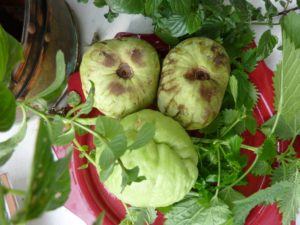
Only 1 week to go until Christmas, and I still haven’t decided on the menu.
To keep my workload manageable but still looking for a wow factor, I start a quest for exotic and unusual fruits and vegetables.
I don’t want to look too far and get overpriced flavorless tropical fruits (once you eat a Mango in Miami you know what a Mango should taste and will not compromise) .
So instead of looking for tropical flavours, I am searching for unusual Mediterranean products that are in season during this Christmas period.
Some of these fruits and vegetables originated from far away countries, but the plants adapted to the Mediterranean climate and now grow locally.
It is fundamental for fruits and vegetables to be produced locally. If they have to travel from far, it usually means that they were harvested too early and so lack flavour. Plus, transportation costs hike up the price.
Not the quality-price ratio I’m looking for!
(see Article A Family Meal Planner Based On Fresh Vegetables)
The products I am searching should be available in local markets or grown in our own garden.
The unusual flavour of those exotic fruits and vegetables creates a festive spirit with no effort, no fat, and plenty of healthy vitamins!
Unusual Mediterranean Fruits
Cherimoya
You may have spotted the Cherimoya in the exotic fruits stand at the Supermarket. It is called Custard Apple in English, and Annona in Italian.
It is originally from South America, but the plant grows well in the Mediterranean climate.
If the fruit is nice, firm and green- don’t buy it!
To be tasty it has to be well matured, soft to the touch, and sporting black stains.
The Cherimoya is a fruit that will not mature well once harvested, and if it’s been picked too early it will be too acidic to eat.
My grandmother use to say that to mature Cherimoyas properly, they have to be stored into a woollen sock. If not, they will turn all black and become inedible.
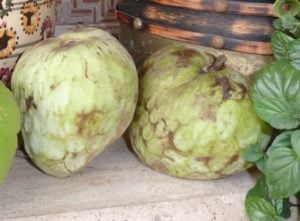
I would not take the risk, and so only buy them when they are at the right maturity stage.
When they are properly ripe, the pulp will be smooth, white and creamy and can be eaten with a spoon.
It is sweet and taste like custard, which is why it is called Custard Apple.
You can find out more about it here: cherimoya
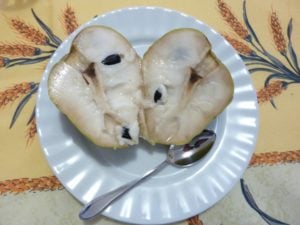
Feijoa
Another fruit originally from South America but nowadays well adapted to the Mediterranean climate is the Feijoa.
They are the same size as figs and when cut in half they look like apples with small seeds inside.
You eat them with a spoon. They have the consistency of a soft apple but will taste more like a citrusy passion fruit.
A very tropical flavor in the heart of the Mediterranean.
Here you find an article from The Guardian: Feijoa
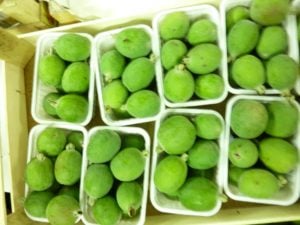
Rowan berries
Rowan berries are in season at Christmas and make fantastic Christmas decorations.
That is all, as far as I am concerned!
I tried them and they are not my favorite.
They have a sandy consistency and lack of taste.
Birds love them though, good for them!
I hung it outside in the garden and it becomes a "live" Christmas decoration with red robins flying in and about.
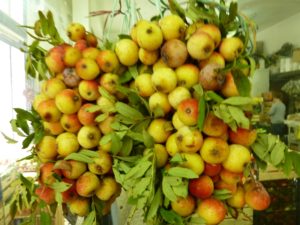
Quince
In French is called Coing and in Italian mela cotogna.
I always ate the paste when I was little but never saw the fruit.
I couldn't believe it is so common in all the other Mediterranean countries.
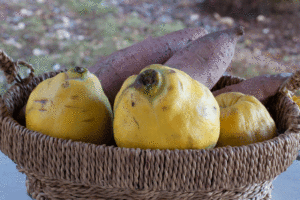
Quince paste, Pâte de Coing in French, Cotognata in Italian and Dulce de Membrillo in Spanish.
No doubt about it, it is a traditional recipe for most Mediterranean countries.
I looked at all the various recipes from each country and it seems they are very similar, so call it as you wish, this is the recipe:
Pâte de Coing in English Quince Paste Recipe
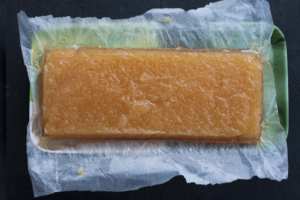
Kaki
My favorite Christmas fruit and tree is the Kaki also called Persimmon.
The best is to eat Kakis when they are well matured and soft. They can be harvest before they are matured.
My friend Anna says: “Store them with apples. They will mature well”
The flesh of the fruit is sweet and smooth like a soft caramel.
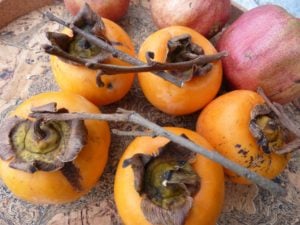
In December the tree naturally becomes a beautiful Christmas decoration.
I love to go for Christmas Mass at the Dominican Convent Passe-Prest , just across the street from The Maeght Foundation .
Every December, the Kaki tree in its court yard reminds me that Christmas is almost here!

Sorry Soeur Rose, I could not resist temptation!!
I refrained from picking them last year, but no one harvest the fruits and they all fell on the ground making a mess.
This year I collected few, but I promise this Sunday I will increase my offering at Mass.
Unusual Mediterranean Vegetables
Avocados
You might be surprised to know but avocados grow well here in the South of France.
We saw the tree in one of our neighbour gardens so we decided to plant one ourselves.
All our hopes were lost as for 5 years we harvest no fruits.
Finally, this year 4 avocados appeared on our tree.
I have now harvested them and put them in a bowl with apples hoping they will be completely matured by Christmas or New Years.
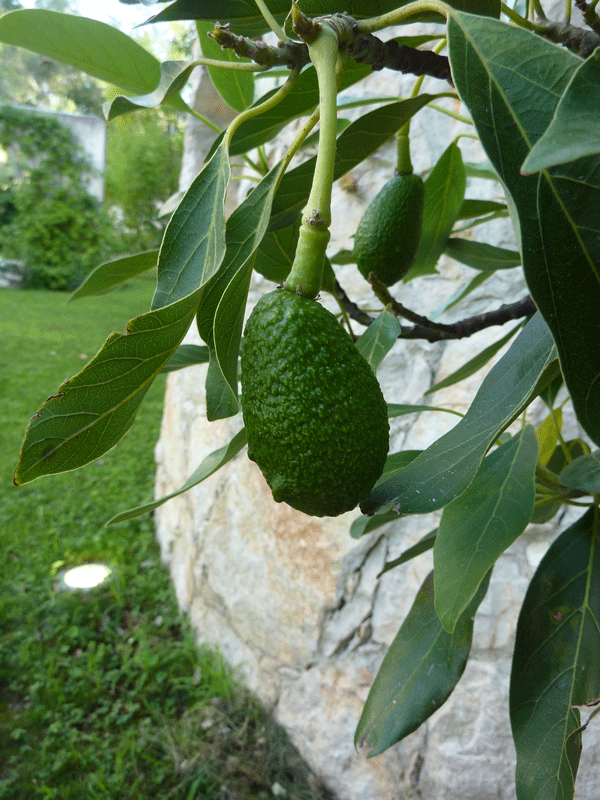
Topinambour
Topinambour is not unusual anymore, but it only appeared in all supermarkets recently.
I cooked the Topinambour for Halloween, and you can read about its benefits in the post: The Healthy Jerusalem Artichoke Soup
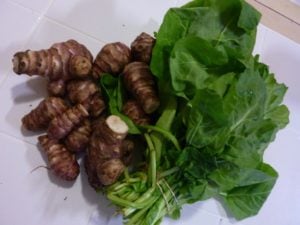
Chicory Puntarelle
The Chicory Puntarelle is a fantastic vegetable, which I have not seen around too much.
It is very common in Italy around this time of the year, and you should be able to find it in the market in Ventimiglia.
Puntarelle alla Romana is a classic during this season in Rome.
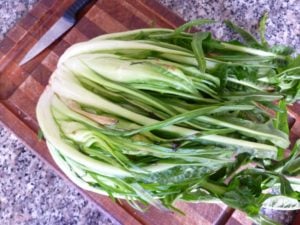
Normally we remove the long leaves and separate the single tooth heads.
The shoots are then cut lengthwise into thin slices and seasoned with a vinaigrette made with olive oil, salt, anchovies, garlic, and lemon.
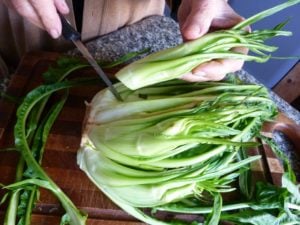
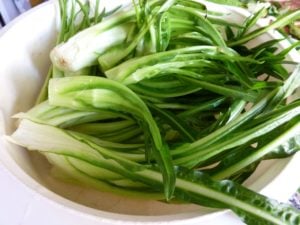
Combawa
I even found the Combawa that Michelin Star Chef Ronan Kervarrec was using to make Gnocchi of San Remo Bay Gamberoni with combawa and samphire grass at the Etoiles de Mougins 2015.
He used the zest to flavour the prawns.
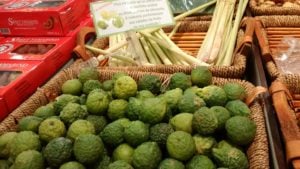
Red Tropea Scallions
On my trip to Tropea, I brought back some Red Tropea Scallions. If they are still fresh I will definitely work with them.
Their sweetness cannot be compared to any other red onion or scallion you would buy in the market.
They have to be grown in Tropea, and only if those who have been here known what they taste like.
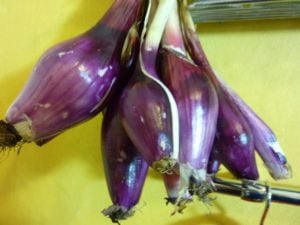
Purple Aubergine
The Purple Aubergine can still be found at the market, and I might cook something with them.
They are a perfect Mediterranean ingredient.
They have fewer seeds than the normal one and they are perfect for grilling.
Winning bet!
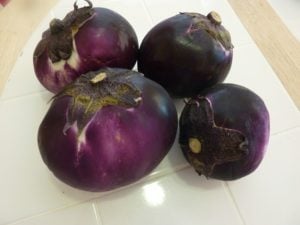
Cime di Rapa
In the Italian market in Ventimiglia, you can find Cime di Rapa, and they are not common in France.
They look like little broccoli but have a bitter taste.
In Italy, we usually serve them with the Orecchiette pasta.
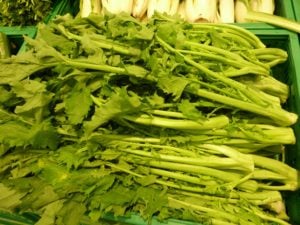
Chayote
There is a vegetable that is not well known but widely sold in every supermarket in the South of France in this period of the year: the Chayote.
In Italian is called Zucchine with needles, as it has soft needles but they are removed before they reach the market.
So unusual but very easy to cook, you can just substitute it for any of your Courgette / Zucchini recipes.
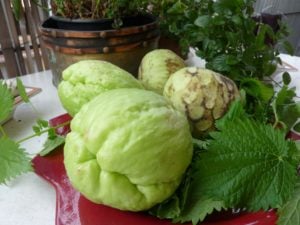

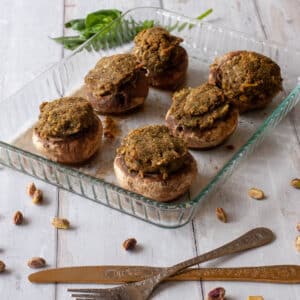
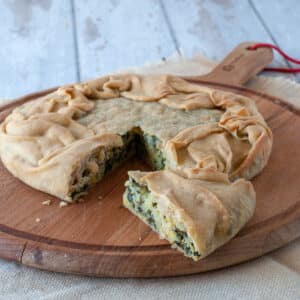
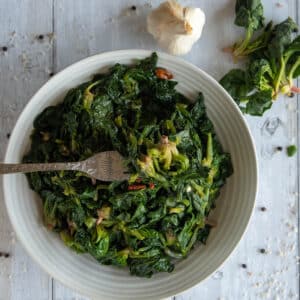

Livia
molto interessante la storia delle verdure e frutta esotica che crescono nell'area mediterranea . Brava Laura come al solito i tuoi articoli ti lasciano informazioni utili e pratiche per avvicinare all'arte della cucina
Livia
Elizabeth
I've only heard of a few of these - we don't get much of a selection of exotic fruits and vegetables where we live, unfortunately.
Laura
That is too bad, keep them in mind next time you travel
Jessica
I wish we had access to these different fruits and vegetables! I love trying new foods!
Laura
Too, bad. Keep your eyes open in your neighborhood, you might find something new locally
Sues
Such a great, informative post! I want to try all of these... beautiful colors and flavors for sure!
Laura
Thanks, a pandora of goodness
Tara
Such a wonderful breakdown of some lesser known ingredients! I have come across Cherimoya and Chayote, but haven't tried working with them yet.
Laura
Thanks, I am sure you would love to cook with them
Jacqueline Meldrum
There are a few new ones there that I'll be looking out for. What a fabulous post!
Laura
Thank you and let me know how you like them
Helen
I would love to organise a show and tell in our kitchen in St Paul with some of these fruits and vegetables next summer if they are in season. I think our friends would find it fascinating. Would you be up for it, Laura?
Laura
Offcourse I am, Helen. That should be fun. Some might not be available but there is always something else in season
Elaine @ Dishes Delish
I really enjoyed reading this post Laura!! I haven't seen a bunch of those fruits or veggies! The one I really want to try is the custard apple. Looks yummy!
Laura
Thank you Elaine. The custard apples are my favourite but rare to find and when I do they are not riped and overpriced. I am really thinking of planing some in the garden
Agness of Run Agness Run
There are plenty of fruits and vegetables on this list which I haven't tried, Laura! Such an enlightening and educative post. Well done!
Laura
Thank you Agness, I am glad you find it useful